Flexible Symmetric-Defection Antenna with Bending and Thermal Insensitivity for Miniaturized UAV
Abstract
1. Introduction
2. Design and Fabrication
2.1. Schematic and Design of the FSDA
2.2. Parameter Optimization of the FSDA
3. Results and Applications
3.1. EM Performance of the FSDA
3.2. Thermal Insensitivity
3.3. Bending Insensitivity
3.4. Aircraft Applications of the FSDA
4. Conclusions
Supplementary Materials
Author Contributions
Funding
Data Availability Statement
Conflicts of Interest
References
- Jia, Q.; Xu, H.; Xiong, M.F.; Zhang, B.; Duan, J. Omnidirectional Solid Angle Beam-Switching Flexible Array Antenna in Millimeter Wave for 5G Micro Base Station Applications. IEEE Access 2019, 7, 157027–157036. [Google Scholar] [CrossRef]
- Kirtania, S.G.; Elger, A.W.; Hasan, M.R.; Wisniewska, A.; Sekhar, K.; Karacolak, T.; Sekhar, P.K. Flexible Antennas: A Review. Micromachines 2020, 11, 847. [Google Scholar] [CrossRef] [PubMed]
- Xie, Z.; Avila, R.; Huang, Y.; Rogers, J.A. Flexible and Stretchable Antennas for Biointegrated Electronics. Adv. Mater. 2019, 32, e1902767. [Google Scholar] [CrossRef] [PubMed]
- Xu, H.; Zhang, B.-Z.; Duan, J.-P.; Cui, J.; Xu, Y.; Tian, Y.; Yan, L.; Xiong, M.; Jia, Q. Wide Solid Angle Beam-Switching Conical Conformal Array Antenna With High Gain for 5G Applications. IEEE Antennas Wirel. Propag. Lett. 2018, 17, 2304–2308. [Google Scholar] [CrossRef]
- Zhao, W.; Ni, H.; Ding, C.; Liu, L.; Fu, Q.; Lin, F.; Tian, F.; Yang, P.; Liu, S.; He, W.; et al. 2D Titanium carbide printed flexible ultrawideband monopole antenna for wireless communications. Nat. Commun. 2023, 14, 278. [Google Scholar] [CrossRef] [PubMed]
- Faisal, F.; Amin, Y.; Cho, Y.; Yoo, H. Compact and Flexible Novel Wideband Flower-Shaped CPW-Fed Antennas for High Data Wireless Applications. IEEE Trans. Antennas Propag. 2019, 67, 4184–4188. [Google Scholar] [CrossRef]
- Bhattacharjee, S.; Maity, S.; Chaudhuri, S.R.B.; Mitra, M. A Compact Dual-Band Dual-Polarized Omnidirectional Antenna for On-Body Applications. IEEE Trans. Antennas Propag. 2019, 67, 5044–5053. [Google Scholar] [CrossRef]
- Sindhu, B.; Kothuru, A.; Sahatiya, P.; Goel, S.; Nandi, S. Laser-Induced Graphene Printed Wearable Flexible Antenna-Based Strain Sensor for Wireless Human Motion Monitoring. IEEE Trans. Electron Devices 2021, 68, 3189–3194. [Google Scholar] [CrossRef]
- Li, H.; Sun, S.; Wang, B.; Wu, F. Design of Compact Single-Layer Textile MIMO Antenna for Wearable Applications. IEEE Trans. Antennas Propag. 2018, 66, 3136–3141. [Google Scholar] [CrossRef]
- Lee, Y.-H.; Lim, E.-H.; Bong, F.-L.; Chung, B.-K. Bowtie-Shaped Folded Patch Antenna With Split Ring Resonators for UHF RFID Tag Design. IEEE Trans. Antennas Propag. 2019, 67, 4212–4217. [Google Scholar] [CrossRef]
- Boyuan, M.; Pan, J.; Wang, E.; Luo, Y. Conformal Bent Dielectric Resonator Antennas With Curving Ground Plane. IEEE Trans. Antennas Propag. 2019, 67, 1931–1936. [Google Scholar] [CrossRef]
- Zhang, J.; Zhang, L.; Wang, Y.; Wang, Y.; Wang, C. Flexible kirigami with local cylindrical shell design for stretchable microstrip antenna. Compos. Struct. 2022, 296, 115879. [Google Scholar] [CrossRef]
- Alemaryeen, A.; Noghanian, S. On-Body Low-Profile Textile Antenna With Artificial Magnetic Conductor. IEEE Trans. Antennas Propag. 2019, 67, 3649–3656. [Google Scholar] [CrossRef]
- Kim, Y.-S.; Basir, A.; Herbert, R.; Kim, J.; Yoo, H.; Yeo, W.-H. Soft Materials, Stretchable Mechanics, and Optimized Designs for Body-Wearable Compliant Antennas. ACS Appl. Mater. Interfaces 2019, 12, 3059–3067. [Google Scholar] [CrossRef] [PubMed]
- Hayes, G.J.; Ju-Hee, S.; Qusba, A.; Dickey, M.D.; Lazzi, G. Flexible Liquid Metal Alloy (EGaIn) Microstrip Patch Antenna. IEEE Trans. Antennas Propag. 2012, 60, 2151–2156. [Google Scholar] [CrossRef]
- Shi, C.; Zhigang, W.; Hallbjorner, P.; Hjort, K.; Rydberg, A. Foldable and Stretchable Liquid Metal Planar Inverted Cone Antenna. IEEE Trans. Antennas Propag. 2009, 57, 3765–3771. [Google Scholar] [CrossRef]
- Sallam, M.O.; Kandil, S.M.; Volski, V.; Vandenbosch, G.A.E.; Soliman, E.A. Wideband CPW-Fed Flexible Bow-Tie Slot Antenna for WLAN/WiMax Systems. IEEE Trans. Antennas Propag. 2017, 65, 4274–4277. [Google Scholar] [CrossRef]
- Kanagasabai, M.; Sambandam, P.; Alsath, M.G.N.; Palaniswamy, S.; Ravichandran, A.; Girinathan, C. Miniaturized Circularly Polarized UWB Antenna for Body Centric Communication. IEEE Trans. Antennas Propag. 2022, 70, 189–196. [Google Scholar] [CrossRef]
- Altinozen, E.; Vukovic, A.; Sewell, P. Assessment of the Robustness of Flexible Antennas to Complex Deformations. IEEE Trans. Antennas Propag. 2023, 71, 4714–4723. [Google Scholar] [CrossRef]
- Jiang, Z.H.; Cui, Z.; Yue, T.; Zhu, Y.; Werner, D.H. Compact, Highly Efficient, and Fully Flexible Circularly Polarized Antenna Enabled by Silver Nanowires for Wireless Body-Area Networks. IEEE Trans. Biomed. Circuits Syst. 2017, 11, 920–932. [Google Scholar] [CrossRef]
- Arif, A.; Zubair, M.; Ali, M.; Khan, M.U.; Mehmood, M.Q. A Compact, Low-Profile Fractal Antenna for Wearable On-Body WBAN Applications. IEEE Antennas Wirel. Propag. Lett. 2019, 18, 981–985. [Google Scholar] [CrossRef]
- Sid, A.; Cresson, P.-Y.; Joly, N.; Braud, F.; Lasri, T. A flexible and wearable dual band bio-based antenna for WBAN applications. AEU—Int. J. Electron. Commun. 2022, 157, 154412. [Google Scholar] [CrossRef]
- Sayem, A.S.M.; Simorangkir, R.B.V.B.; Esselle, K.P.; Hashmi, R.M.; Liu, H. A Method to Develop Flexible Robust Optically Transparent Unidirectional Antennas Utilizing Pure Water, PDMS, and Transparent Conductive Mesh. IEEE Trans. Antennas Propag. 2020, 68, 6943–6952. [Google Scholar] [CrossRef]
- Zhang, S.; Zhu, J.; Zhang, Y.; Chen, Z.; Song, C.; Li, J.; Yi, N.; Qiu, D.; Guo, K.; Zhang, C.; et al. Standalone stretchable RF systems based on asymmetric 3D microstrip antennas with on-body wireless communication and energy harvesting. Nano Energy 2022, 96, 107069. [Google Scholar] [CrossRef]
- Song, L.; Rahmat-Samii, Y. A Systematic Investigation of Rectangular Patch Antenna Bending Effects for Wearable Applications. IEEE Trans. Antennas Propag. 2018, 66, 2219–2228. [Google Scholar] [CrossRef]
- Li, W.; Hei, Y.; Grubb, P.M.; Shi, X.; Chen, R.T. Compact Inkjet-Printed Flexible MIMO Antenna for UWB Applications. IEEE Access 2018, 6, 50290–50298. [Google Scholar] [CrossRef]
- Liu, Y.; Wang, Z.-L.; Cang, D.-Y.; Gong, J.-S.; Qu, H.-W. A polyimide-based flexible monopole antenna. J. Mater. Sci. Mater. Electron. 2022, 33, 1686–1702. [Google Scholar] [CrossRef]
- Mahfuz, M.M.H.; Park, C.-W. Review of Patch Antennas used in Drone Applications. IEEE Access 2023, 11, 58367–58388. [Google Scholar] [CrossRef]
- Yao, J.; Mbanya Tchafa, F.; Jain, A.; Tjuatja, S.; Huang, H. Far-Field Interrogation of Microstrip Patch Antenna for Temperature Sensing Without Electronics. IEEE Sens. J. 2016, 16, 7053–7060. [Google Scholar] [CrossRef]
- Tchafa, F.M.; Huang, H. Microstrip patch antenna for simultaneous temperature sensing and superstrate characterization. Smart Mater. Struct. 2019, 28, 105009. [Google Scholar] [CrossRef]
- Sanders, J.W.; Yao, J.; Huang, H. Microstrip Patch Antenna Temperature Sensor. IEEE Sens. J. 2015, 15, 5312–5319. [Google Scholar] [CrossRef]
- Miao, F.; Tian, P.; Tao, B.; Zang, Y. Passive RFID microstrip antenna sensor for temperature monitoring. Vacuum 2022, 201, 111108. [Google Scholar] [CrossRef]
- Xu, H.; Cui, J.; Duan, J.; Zhang, B.; Tian, Y. Versatile Conical Conformal Array Antenna Based on Implementation of Independent and Endfire Radiation for UAV Applications. IEEE Access 2019, 7, 31207–31217. [Google Scholar] [CrossRef]
- Kou, H.; Yang, L.; Zhang, X.; Shang, Z.; Shi, J.; Wang, X. Wireless Passive Microwave Antenna-Integrated Temperature Sensor Based on CSRR. Micromachines 2022, 13, 621. [Google Scholar] [CrossRef] [PubMed]
- Tchafa, F.M.; Huang, H. Microstrip patch antenna for simultaneous strain and temperature sensing. Smart Mater. Struct. 2018, 27, 065019. [Google Scholar] [CrossRef]
- Xu, H.; Zheng, W.; Yuan, Y.; Xu, D.; Qin, Y.; Zhao, N.; Duan, Q.; Jin, Y.; Wang, Y.; Wang, W.; et al. Flexible Gas-Permeable and Resilient Bowtie Antenna for Tensile Strain and Temperature Sensing. IEEE Internet Things J. 2022, 9, 23215–23223. [Google Scholar] [CrossRef]
- Bhattacharjee, M.; Nikbakhtnasrabadi, F.; Dahiya, R. Printed Chipless Antenna as Flexible Temperature Sensor. IEEE Internet Things J. 2021, 8, 5101–5110. [Google Scholar] [CrossRef]
- Wei, Z.; Junfeng, Y. Design of L-Shaped Open-Slot Antenna Used in UAV Airborne Communication System. Int. J. Antennas Propag. 2018, 2018, 6846193. [Google Scholar] [CrossRef]
- Huang, Y.-H.; Wang, Y.; Zou, Y.-L.; Guo, J.-L. A Miniature Circularly Polarized Air-Borne Antenna With Wide Angle Coverage. IEEE Antennas Wirel. Propag. Lett. 2017, 16, 497–500. [Google Scholar] [CrossRef]
- Yang, X.; Qi, Y.; Yuan, B.; Cao, Y.; Wang, G.; Casula, G.A. A Miniaturized High-Gain Flexible Antenna for UAV Applications. Int. J. Antennas Propag. 2021, 2021, 9919425. [Google Scholar] [CrossRef]
- Agneessens, S.; Rogier, H. Compact Half Diamond Dual-Band Textile HMSIW On-Body Antenna. IEEE Trans. Antennas Propag. 2014, 62, 2374–2381. [Google Scholar] [CrossRef]
- Velan, S.; Sundarsingh, E.F.; Kanagasabai, M.; Sarma, A.K.; Raviteja, C.; Sivasamy, R.; Pakkathillam, J.K. Dual-Band EBG Integrated Monopole Antenna Deploying Fractal Geometry for Wearable Applications. IEEE Antennas Wirel. Propag. Lett. 2015, 14, 249–252. [Google Scholar] [CrossRef]
- Moscato, S.; Bahr, R.; Le, T.; Pasian, M.; Bozzi, M.; Perregrini, L.; Tentzeris, M.M. Infill-Dependent 3-D-Printed Material Based on NinjaFlex Filament for Antenna Applications. IEEE Antennas Wirel. Propag. Lett. 2016, 15, 1506–1509. [Google Scholar] [CrossRef]
- Smida, A.; Iqbal, A.; Alazemi, A.J.; Waly, M.I.; Ghayoula, R.; Kim, S. Wideband Wearable Antenna for Biomedical Telemetry Applications. IEEE Access 2020, 8, 15687–15694. [Google Scholar] [CrossRef]
- Abhinav, K.V.; Rao, R.V.K.; Karthik, P.S.; Singh, S.P. Copper conductive inks: Synthesis and utilization in flexible electronics. RSC Adv. 2015, 5, 63985–64030. [Google Scholar] [CrossRef]
- Lamminen, A.; Arapov, K.; de With, G.; Haque, S.; Sandberg, H.G.O.; Friedrich, H.; Ermolov, V. Graphene-Flakes Printed Wideband Elliptical Dipole Antenna for Low-Cost Wireless Communications Applications. IEEE Antennas Wirel. Propag. Lett. 2017, 16, 1883–1886. [Google Scholar] [CrossRef]
- Rizwan, M.; Khan, M.W.A.; Sydanheimo, L.; Virkki, J.; Ukkonen, L. Flexible and Stretchable Brush-Painted Wearable Antenna on a Three-Dimensional (3-D) Printed Substrate. IEEE Antennas Wirel. Propag. Lett. 2017, 16, 3108–3112. [Google Scholar] [CrossRef]
- Abutarboush, H.F.; Li, W.; Shamim, A. Flexible-Screen-Printed Antenna With Enhanced Bandwidth by Employing Defected Ground Structure. IEEE Antennas Wirel. Propag. Lett. 2020, 19, 1803–1807. [Google Scholar] [CrossRef]
- Sreelekshmi, S.; Perumal Sankar, S. A square ring and single split resonator based wearable antenna for Microwave energy harvesting for IoT nodes. Sustain. Energy Technol. Assess. 2022, 52, 102217. [Google Scholar] [CrossRef]
- EI-Hameed, A.S.A.; Salem, D.A.; Abdallah, E.A. Ultra Wide Band CPW-Fed Circularly PolarizedSquare Slot Antenna. In Proceedings of the 2013 IEEE Antennas and Propagation Society International Symposium (APSURSI), Orlando, FL, USA, 7–13 July 2013; p. 2. [Google Scholar] [CrossRef]
- Qiao, X.; Geng, W.; Chen, X.; Zhang, L.; Zheng, D.; Zhang, L.; He, J.; Hou, X.; Yang, Y.; Cui, M.; et al. Enhanced energy storage properties and temperature stability of fatigue-free La-modified PbZrO3 films under low electric fields. Sci. China Mater. 2020, 63, 2325–2334. [Google Scholar] [CrossRef]
- Qiao, X.; Geng, W.; Sun, Y.; Yu, J.; Chen, X.; Yang, Y.; Cui, M.; Hou, X.; Zeng, K.; Chou, X. Preparation of high piezoelectric and flexible polyvinylidene fluoride nanofibers via lead zirconium titanate doping. Ceram. Int. 2020, 46, 28735–28741. [Google Scholar] [CrossRef]
- Li, J.; Jiang, Y.; Zhao, X. Circularly Polarized Wearable Antenna Based on NinjaFlex-Embedded Conductive Fabric. Int. J. Antennas Propag. 2019, 2019, 3059480. [Google Scholar] [CrossRef]
- Sayem, A.S.M.; Simorangkir, R.B.V.B.; Esselle, K.P.; Hashmi, R.M. Development of Robust Transparent Conformal Antennas Based on Conductive Mesh-Polymer Composite for Unobtrusive Wearable Applications. IEEE Trans. Antennas Propag. 2019, 67, 7216–7224. [Google Scholar] [CrossRef]
- Sayem, A.S.M.; Simorangkir, R.B.V.B.; Esselle, K.P.; Lalbakhsh, A.; Gawade, D.R.; O’Flynn, B.; Buckley, J.L. Flexible and Transparent Circularly Polarized Patch Antenna for Reliable Unobtrusive Wearable Wireless Communications. Sensors 2022, 22, 1276. [Google Scholar] [CrossRef] [PubMed]
- Awang, Z.; Affendi, N.A.M.; Alias, N.A.L.; Razal, N.M. Flexible Antennas Based on Natural Rubber. Prog. Electromagn. Res. C 2016, 61, 75–90. [Google Scholar] [CrossRef]
- Althuwayb, A.A.; Alibakhshikenari, M.; Virdee, B.S.; Rashid, N.; Kaaniche, K.; Atitallah, A.B.; Armghan, A.; Elhamrawy, O.I.; See, C.H.; Falcone, F. Metasurface-Inspired Flexible Wearable MIMO Antenna Array for Wireless Body Area Network Applications and Biomedical Telemetry Devices. IEEE Access 2023, 11, 1039–1056. [Google Scholar] [CrossRef]
- Bolaños-Torres, M.Á.; Torrealba-Meléndez, R.; Muñoz-Pacheco, J.M.; Goméz-Pavón, L.d.C.; Tamariz-Flores, E.I. Multiband Flexible Antenna for Wearable Personal Communications. Wirel. Pers. Commun. 2018, 100, 1753–1764. [Google Scholar] [CrossRef]
- Ullah, M.; Islam, M.; Alam, T.; Ashraf, F. Paper-Based Flexible Antenna for Wearable Telemedicine Applications at 2.4 GHz ISM Band. Sensors 2018, 18, 4214. [Google Scholar] [CrossRef]
- Haagenson, T.; Noghanian, S.; de Leon, P.; Chang, Y.-h. Textile Antennas for Spacesuit Applications: Design, simulation, manufacturing, and testing of textile patch antennas for spacesuit applications. IEEE Antennas Propag. Mag. 2015, 57, 64–73. [Google Scholar] [CrossRef]
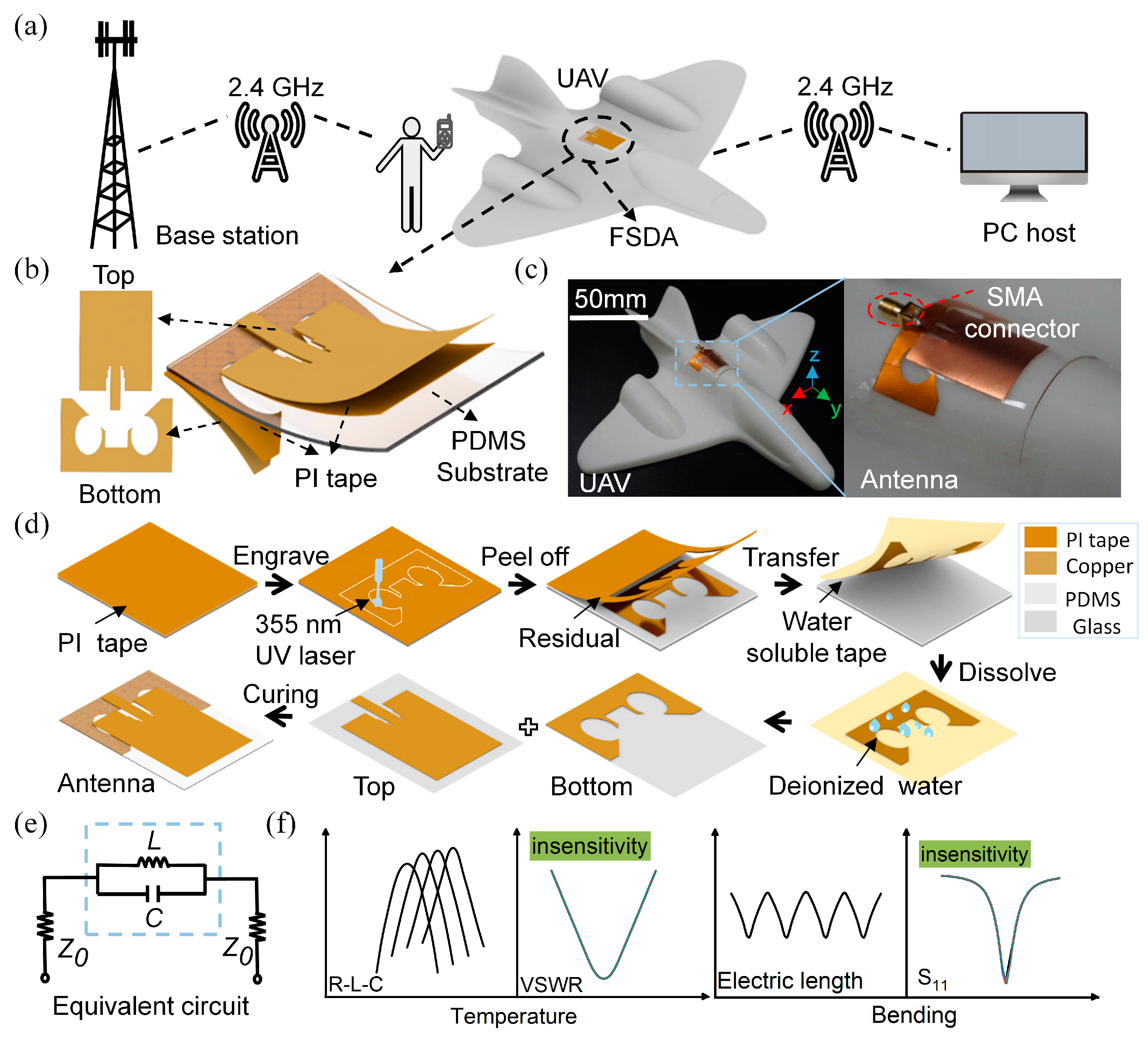

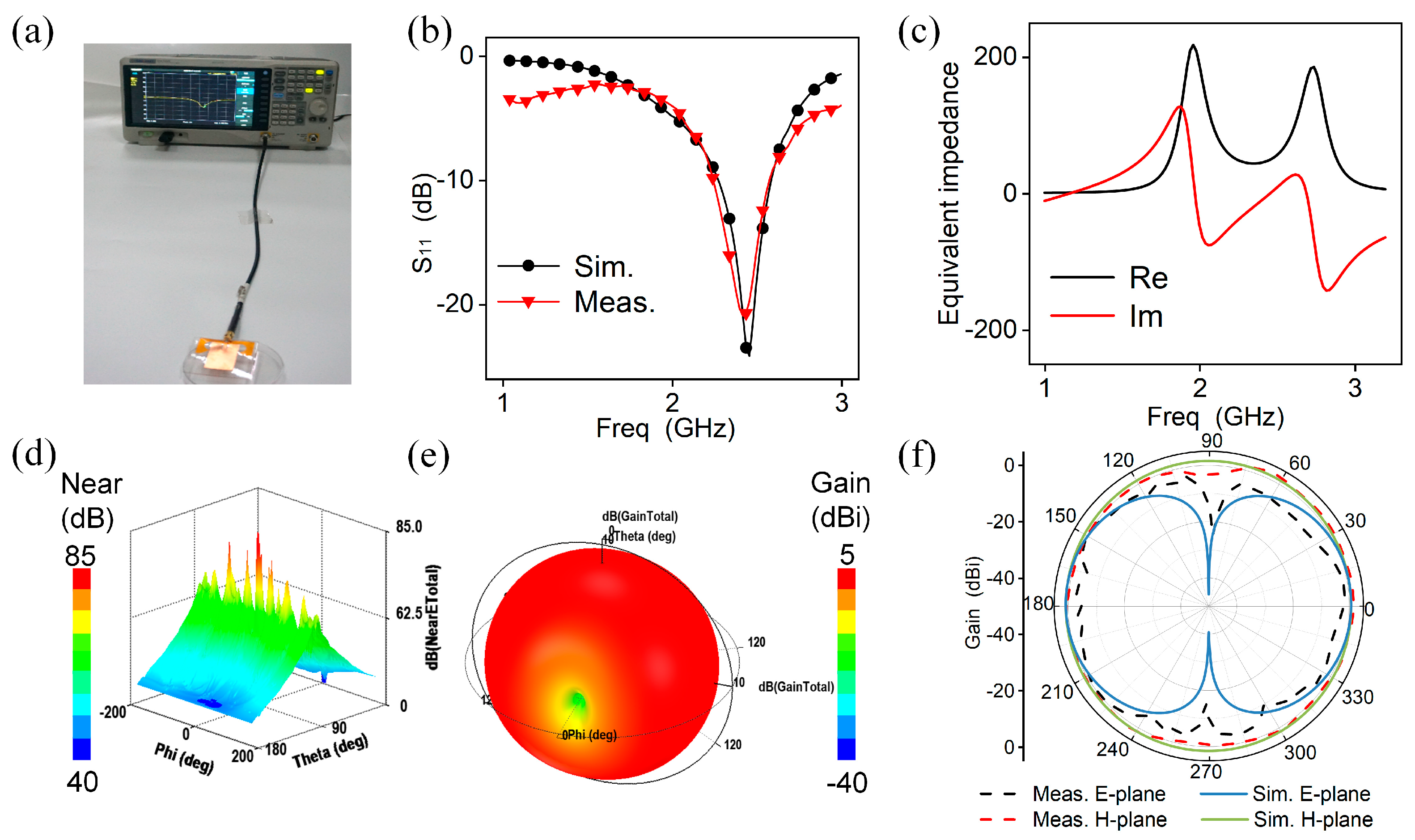
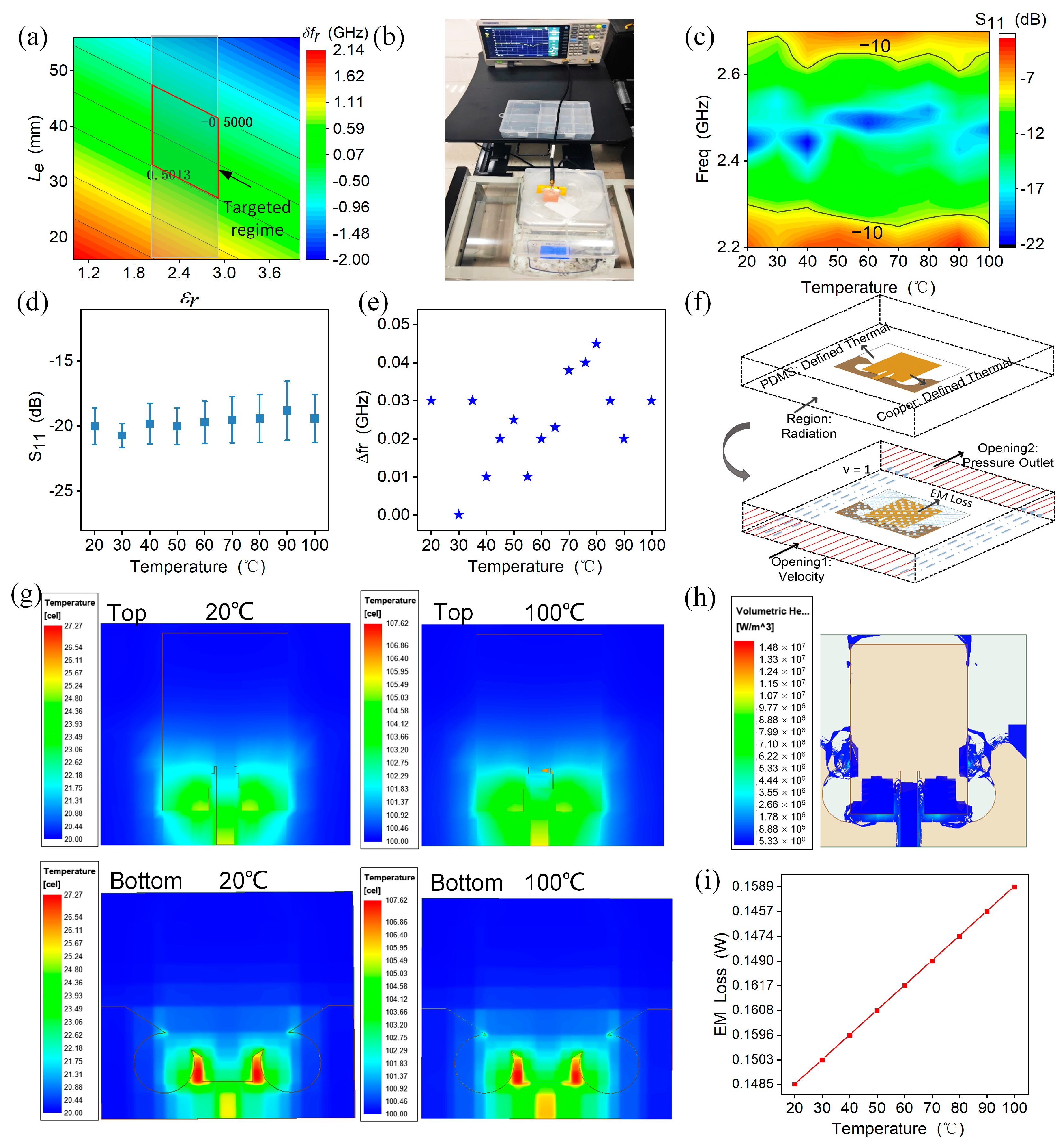
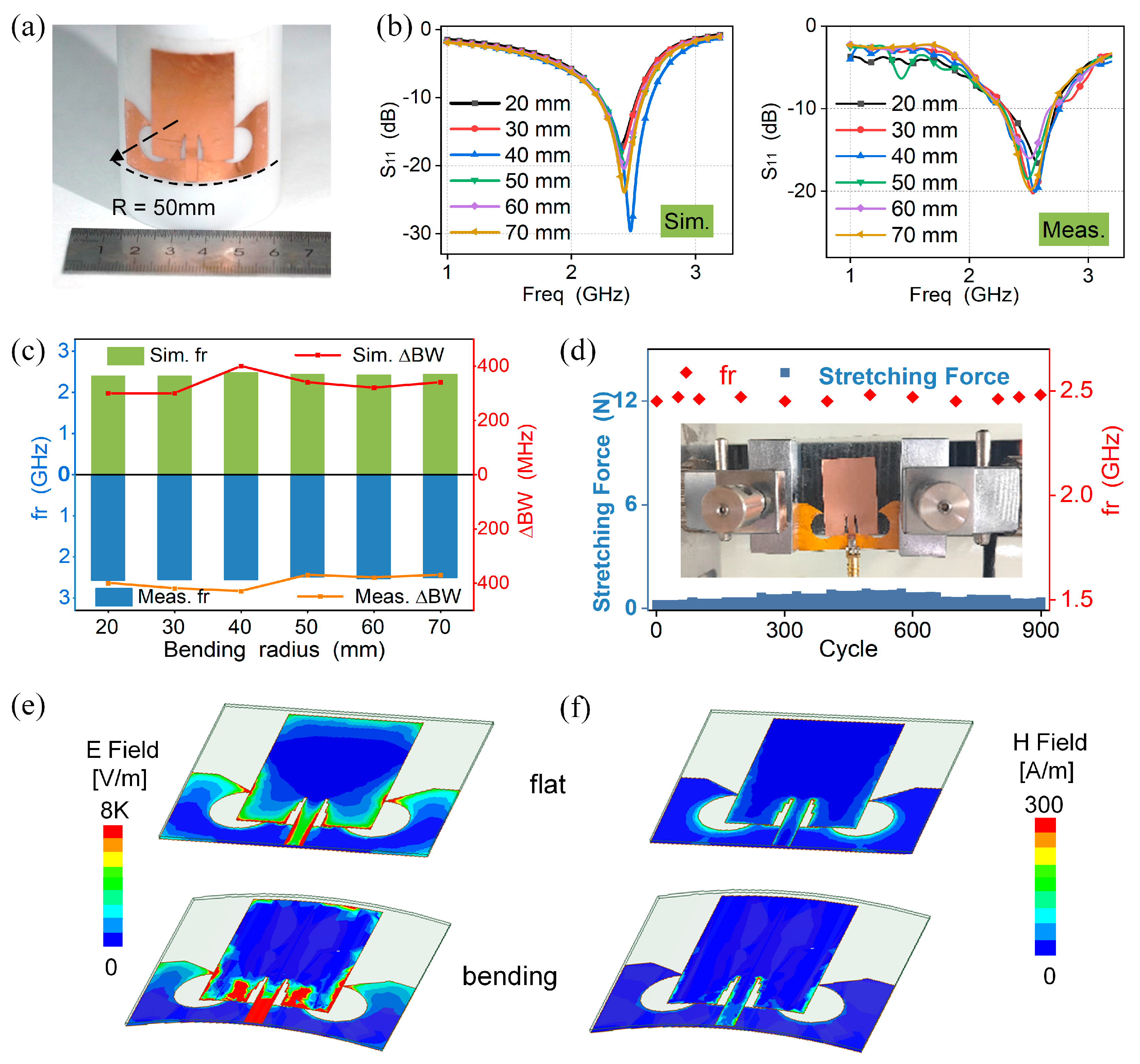
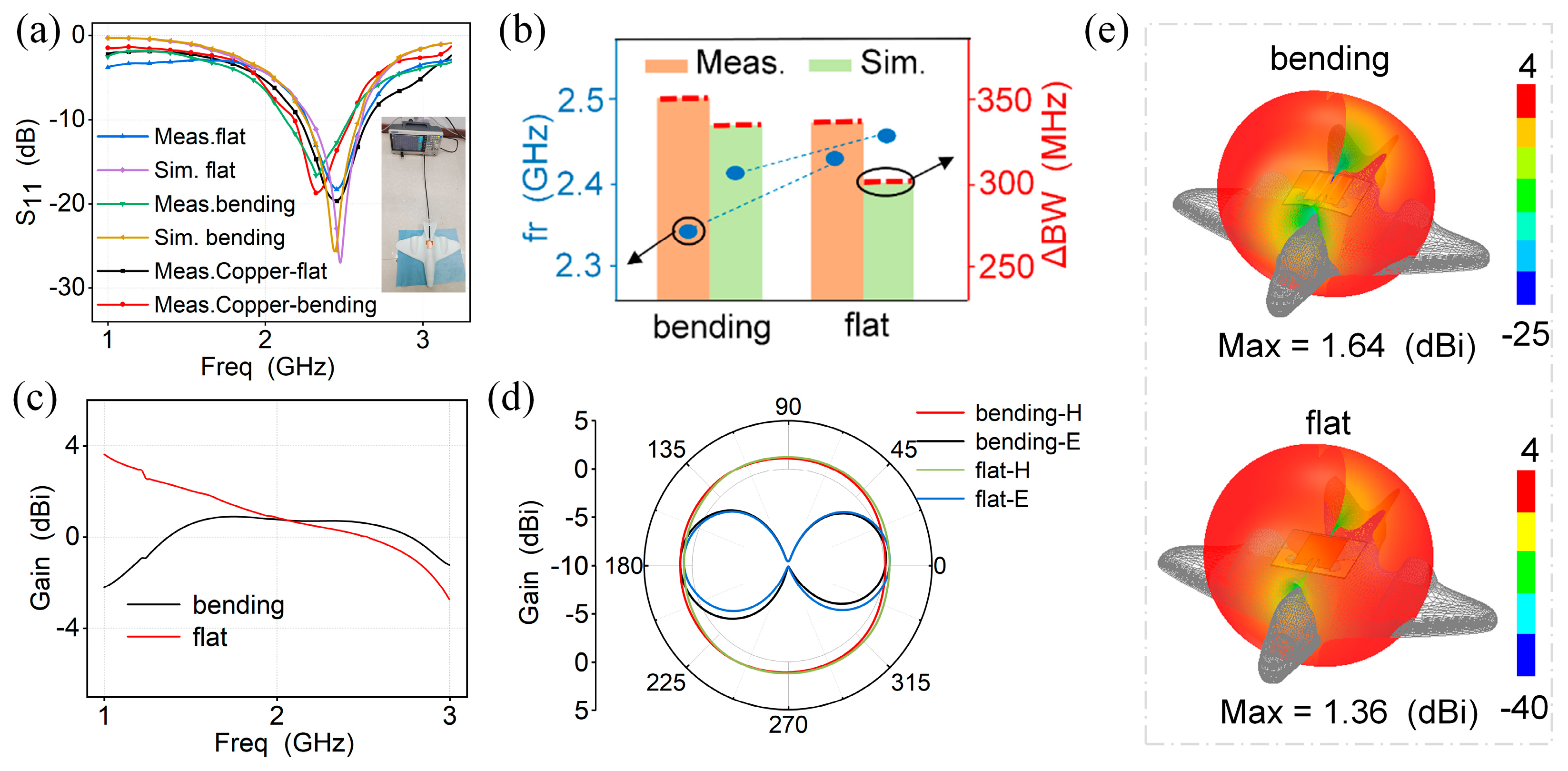
| Parameter | Value (mm) |
|---|---|
| 45 | |
| 49.9 | |
| 36 | |
| 25 | |
| 7 | |
| 3.5 | |
| 0.008 | |
| 0.05 | |
| 0.54 | |
| 0.51 | |
| 4.5 | |
| 7.5 | |
| 9 | |
| 6 | |
| 15 | |
| 10 |
| Ref. | Flat | Bending | Thermal | ||||||||
|---|---|---|---|---|---|---|---|---|---|---|---|
| (GHz) | S11 (dB) | (MHz) | Efficiency (%) | Radius/Angle | (dB) | (MHz) | Efficiency (%) | Durability | |||
| [27] | 2.32 | −28 | 760 | NA | 40 (mm) | 3% | 10.84 | 310 | NA | NA | NA |
| [37] | 1.2/5.8 | −13/−20 | 220/4000 | NA | S11 > −10 dB at lateral bending, mismatching | NA | NA | ~20% at 5.8 GHz | |||
| [53] | 2.4 | −21 | 275 | 25.8% | 25 (mm) | 4.4% | 3 | 65 | 27.5% | NA | NA |
| [54] | 2.45/5 | −24/−14 | 170/700 | 37%/44% | 28 | 2.1% | 6/10 | 80/200 | 32%/36% | √ | NA |
| [55] | 2.53 | −15 | 350 | 42.3% | 70 (mm) | 3.3% | 2 | 190 | NA | NA | NA |
| [56] | 2.45 | −22 | 128 | 30.5% | 60° | 0.4% | 10 | 20 | 27.9% | NA | NA |
| [57] | 5.7 | −50 | 1600 | 80% | 43 | 1.8% | 24 | 100 | 83.5% | √ | NA |
| [58] | 2.43 | −33 | 260 | NA | 40° | 2% | 19 | 80 | NA | NA | NA |
| [59] | 2.47 | −21 | 250 | 83% | 30 (mm) | 3.6% | 8 | 100 | 70% | NA | NA |
| [60] | 2.43 | −42 | 50 | NA | 43.2 | 0.8% | 19 | 5 | NA | √ | NA |
| This work | 2.45 | −22 | 330 | 86% | 40 (mm) | 2.8% | 1 | 100 | 84% | √ | ~ 45 MHz, ~ 4 dB |
Disclaimer/Publisher’s Note: The statements, opinions and data contained in all publications are solely those of the individual author(s) and contributor(s) and not of MDPI and/or the editor(s). MDPI and/or the editor(s) disclaim responsibility for any injury to people or property resulting from any ideas, methods, instructions or products referred to in the content. |
© 2024 by the authors. Licensee MDPI, Basel, Switzerland. This article is an open access article distributed under the terms and conditions of the Creative Commons Attribution (CC BY) license (https://creativecommons.org/licenses/by/4.0/).
Share and Cite
Nan, X.; Kang, T.; Zhang, Z.; Wang, X.; Zhang, J.; Lei, Y.; Gao, L.; Cui, J.; Xu, H. Flexible Symmetric-Defection Antenna with Bending and Thermal Insensitivity for Miniaturized UAV. Micromachines 2024, 15, 159. https://doi.org/10.3390/mi15010159
Nan X, Kang T, Zhang Z, Wang X, Zhang J, Lei Y, Gao L, Cui J, Xu H. Flexible Symmetric-Defection Antenna with Bending and Thermal Insensitivity for Miniaturized UAV. Micromachines. 2024; 15(1):159. https://doi.org/10.3390/mi15010159
Chicago/Turabian StyleNan, Xueli, Tongtong Kang, Zhonghe Zhang, Xin Wang, Jiale Zhang, Yusheng Lei, Libo Gao, Jianli Cui, and Hongcheng Xu. 2024. "Flexible Symmetric-Defection Antenna with Bending and Thermal Insensitivity for Miniaturized UAV" Micromachines 15, no. 1: 159. https://doi.org/10.3390/mi15010159
APA StyleNan, X., Kang, T., Zhang, Z., Wang, X., Zhang, J., Lei, Y., Gao, L., Cui, J., & Xu, H. (2024). Flexible Symmetric-Defection Antenna with Bending and Thermal Insensitivity for Miniaturized UAV. Micromachines, 15(1), 159. https://doi.org/10.3390/mi15010159






